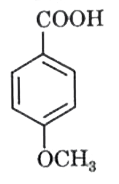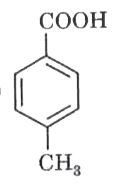Which of the following is most acidic ?




The correct Answer is:A
To determine which of the given compounds is the most acidic, we need to analyze the stability of the conjugate base formed when each acid donates a proton (H+). The more stable the conjugate base, the stronger the acid.
1. Identify the Compounds:
Let's denote the compounds as A, B, C, and D. Assume they are different benzoic acids with varying substituents (e.g., nitro, methyl, etc.).
2. Understand the Acid-Base Reaction:
When an acid (HA) donates a proton, it forms a conjugate base (A-). The acidity of HA can be assessed by the stability of A-.
3. Draw the Conjugate Bases:
For each compound, draw the structure of the conjugate base after the proton is removed. This will help visualize the stabilization of the negative charge.
4. Analyze the Stabilization Factors:
The stability of the conjugate base can be influenced by:
- Inductive Effect: Electronegative groups (like -NO2) can stabilize the negative charge through the inductive effect.
- Resonance: If the negative charge can be delocalized over multiple atoms, it increases stability.
- Hyperconjugation: Alkyl groups can destabilize the negative charge due to electron-donating effects.
5. Compare the Effects of Substituents:
- Compound with -NO2 (Nitro Group): This group has a strong -M (minus mesomeric) effect, which stabilizes the negative charge on the conjugate base by delocalization.
- Compound with -CH3 (Methyl Group): This group has a +I (plus inductive) effect, which destabilizes the negative charge.
- Compound with no substituents: This will have moderate stability.
- Compound with -OCH3 (Methoxy Group): This group has a +M effect, which can also destabilize the negative charge.
6. Determine the Most Acidic Compound:
Based on the above analysis, the compound with the nitro group (-NO2) will be the most acidic because it effectively stabilizes the conjugate base through resonance and inductive effects.
Conclusion:
The most acidic compound among A, B, C, and D is the one with the nitro group, which is nitrobenzoic acid.
---
Let's denote the compounds as A, B, C, and D. Assume they are different benzoic acids with varying substituents (e.g., nitro, methyl, etc.).
When an acid (HA) donates a proton, it forms a conjugate base (A-). The acidity of HA can be assessed by the stability of A-.
For each compound, draw the structure of the conjugate base after the proton is removed. This will help visualize the stabilization of the negative charge.
The stability of the conjugate base can be influenced by:
- Inductive Effect: Electronegative groups (like -NO2) can stabilize the negative charge through the inductive effect.
- Resonance: If the negative charge can be delocalized over multiple atoms, it increases stability.
- Hyperconjugation: Alkyl groups can destabilize the negative charge due to electron-donating effects.
- Compound with -NO2 (Nitro Group): This group has a strong -M (minus mesomeric) effect, which stabilizes the negative charge on the conjugate base by delocalization.
- Compound with -CH3 (Methyl Group): This group has a +I (plus inductive) effect, which destabilizes the negative charge.
- Compound with no substituents: This will have moderate stability.
- Compound with -OCH3 (Methoxy Group): This group has a +M effect, which can also destabilize the negative charge.
Based on the above analysis, the compound with the nitro group (-NO2) will be the most acidic because it effectively stabilizes the conjugate base through resonance and inductive effects.
The most acidic compound among A, B, C, and D is the one with the nitro group, which is nitrobenzoic acid.
Topper's Solved these Questions
- BOOK - MODERN PUBLICATIONCHAPTER - ALDEHYDES ,KETONES AND CARBOXYLIC ACIDSEXERCISE - REVISION EXERCISES (OBJECTIVE QUESTIONS - PASSAGE BASED QUESTIONS )10videos
ALDEHYDES ,KETONES AND CARBOXYLIC ACIDS
- BOOK - MODERN PUBLICATIONCHAPTER - ALDEHYDES ,KETONES AND CARBOXYLIC ACIDSEXERCISE - REVISION EXERCISES (OBJECTIVE QUESTIONS - ASSERTION REASON QUESTIONS )10videos
ALDEHYDES ,KETONES AND CARBOXYLIC ACIDS
- BOOK - MODERN PUBLICATIONCHAPTER - ALDEHYDES ,KETONES AND CARBOXYLIC ACIDSEXERCISE - QUICK MEMORY TEST ( C. CHOOSE THE CORRECT ALTERNATIVE )19videos
ALDEHYDES ,KETONES AND CARBOXYLIC ACIDS
- BOOK - MODERN PUBLICATIONCHAPTER - ALCOHOLS, PHENOLS AND ETHERSEXERCISE - UNIT PRACTICE TEST (FOR BOARD EXAMINATION)12videos
ALCOHOLS, PHENOLS AND ETHERS
- BOOK - MODERN PUBLICATIONCHAPTER - BIOMOLECULESEXERCISE - UNIT PRACTICE TEST FOR BOARD EXAMINATION13videos
BIOMOLECULES
Similar Questions
Knowledge Check
- Question 1 - Select One
Which of the following has most acidic proton :
ACH3COCH3B(CH3)2C=CH3CCH3COCH2COCH3D(CH3CH)3CH. - Question 2 - Select One
Which of the following has most acidic hydrogen ?
AHexan-3-oneBHexan-2,4-dioneCHexana-2,5-dioneDHexan-2,3-dione ? - Question 3 - Select One
Which of the following has most acidic hydrogen?
ACH3−NO2BCH3−O∣∣C−HCH−C(NO2)3DPh3CH

